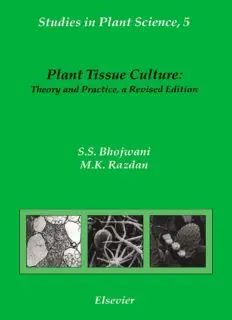
Plant Tissue Culture: Theory and Practice, a Revised Edition PDF
Preview Plant Tissue Culture: Theory and Practice, a Revised Edition
Plant Tissue Culture: Theory and Practice, a Revised Edition Plant Tissue Culture: Theory and Practice, a Revised Edition This Page Intentionally Left Blank P l a n t Tissue Culture: Theory and Practice, a Revised Edition Preface Since the publication of this book, in 1983, several new and exciting developments have taken place in the field of Plant Tissue Culture, and it now forms a major component of what is popularly called Plant Bio- technology. Many of the important crop plants which were then regarded as recalcitrant are now amenable to regeneration from cultured proto- plasts, cells, and calli, enabling subjection of these crops to improvement by biotechnological methods of cell manipulation. Embryogenic cultures can be established for most of the important crop plants, including many hardwood and softwood tree species. During the last decade the emphasis of research in tissue culture has been on its industrial and agricultural applications. Chief among the proven applications of plant tissue culture are the routine use of andro- genesis in plant breeding programmes (Chapter 7), development of new varieties through somaclonal and gametoclonal variant selection (Chap- ter 9), production of industrial compounds (Chapter 17), regeneration of transgenic plants from genetically manipulated cells (Chapter 15), clonal propagation of horticultural and forest species (Chapter 16), and conser- vation of germplasm of crop plants and endangered species (Chapter 18). In the process of translating the laboratory protocols into commercial protocols several problems were identified and research was focused on finding solutions thereof. Until the early 1980s, for example, most of the contributions on somatic embryogenesis concerned the differentiation of structures that resembled embryos but when the protocols were critically examined for application to commercial plant propagation it was soon realized that the somatic embryos showed an extremely low degree of germination owing to their physiological and biochemical immaturity. This necessitated introduction of an additional stage of embryo matura- tion to ensure an acceptably high rate of conversion of somatic embryos into plantlets. Concurrently, mass production of somatic embryos in bioreactors has been studied and synthetic seed technology has been de- veloped to facilitate their mechanized field planting. Fermentor technol- ogy has also been developed for large scale plant cell culture (Chapter 4) required in industrial production of secondary plant products. These developments and the gratifying world-wide response the earlier edition of this book received, provided the impetus to update it under the earlier title. All the chapters in the first edition have been thoroughly revised without disturbing the original character. Two new chapters, one vi on 'Production of Industrial Compounds' (Chapter 17) and another on 'Genetic Engineering' (Chapter 14), have been added. The chapter on 'Cytogenetic Studies' has been revised with emphasis on applied aspects and retitled as ~Variant Selection' (Chapter 9). When the revision of the book was contemplated, I did not realize the magnitude of the task. The proliferation of literature has been such that each chapter or, in some instances, even a section of it can be and indeed has been developed as a book. The last decade has witnessed movement of many tissue culture scientists from public sector institutions to private commercial laboratories which are making notable contributions. How- ever, due to this shift from the 'open research system' of universities and government institutes to the 'closely guarded research system' of indus- try, the scientific information often remains unknown until the process and/or the product are patented. I hope that our earnest endeavour will have a greater reception by students, teachers and plant scientists interested in both theoretical and applied aspects of plant tissue culture. I am indebted to my co-author, Dr M.K. Razdan, for his help and co- operation in completing the manuscript. I am highly obliged to Dr Arlette Reynaerte for valuable suggestions on the manuscript of Chapter 14. I am grateful to several of my colleagues and students, particularly Profes- sor S.P. Bhatnagar, Dr W. Marubashi, Mr A.P. Raste, Dr P.K. Dantu, Himani Pande, Pradeep Kumar, Ashwani Kumar, Dennis Thomas, Deepali Saxena and Sushma Arora for their help in various ways. I thank Mr S.K. Das, Mr J.P. Narayan and Mr Manwar Singh for their constant cooperation in photography and preparation of the illustrations and the manuscript, respectively. The task of completing this book could not have been accomplished without the patience and understanding of my wife, Shaku. I lovingly dedicate this book to her. Sant Saran Bhojwani Delhi, India February 29, 1996 vii Contents Preface ................................................................................................................... v Chapter 1. Introductory history ........................................................................ 1 Chapter 2. Laboratory requirements and general techniques ......................... 19 Chapter 3. Tissue culture media ....................................................................... 39 Chapter 4. Cell culture ...................................................................................... 63 Chapter 5. Cellular totipotency ......................................................................... 95 Chapter 6. Somatic embryogenesis ................................................................... 125 Chapter 7. Haploid production .......................................................................... 167 Chapter 8. Triploid production .......................................................................... 215 Chapter 9. Variant selection .............................................................................. 231 Chapter 10. In vitro pollination and fertilization ............................................... 269 Chapter 11. Zygotic embryo culture .................................................................... 297 Chapter 12. Protoplast isolation and culture ..................................................... 337 Chapter 13. Somatic hybridization and cybridization ........................................ 373 Chapter 14. Genetic engineering ......................................................................... 407 Chapter 15. Production of pathogen-free plants ................................................. 451 Chapter 16. Clonal propagation .......................................................................... 483 Chapter 17. Production of secondary metabolites .............................................. 537 Chapter 18. Germplasm storage ......................................................................... 563 Glossary of terms commonly used in plant tissue culture .................................. 589 References ............................................................................................................. 603 Subject and plant index ........................................................................................ 749 This Page Intentionally Left Blank ERRATA Plant Tissue Culture: Theory and Practice, a Revised Edition S.S. B hojwani and M.K. Razdan ISBN: 0.444.81623.2 The lines below should read as follows. Page 184 - line 10 buds centrifuged at 400 g for 4, 8 or 12 min or at 280 g for 5 or 10 min. All Page 193 - line 5 A 12 h pulse treatment of pollen grains with 25 mg 1" ~ of colchicine, an Page 425 - line 36 rice (Christou et al., 1991) and maize (Gordon Kamm et al., 1990), thus
